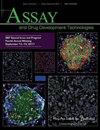调整基于荧光的剂量反应激酶抑制测定的拟合以考虑荧光抑制剂。
IF 1.7
4区 医学
Q4 BIOCHEMICAL RESEARCH METHODS
Assay and drug development technologies
Pub Date : 2023-10-01
Epub Date: 2023-09-28
DOI:10.1089/adt.2023.044
引用次数: 0
摘要
荧光在商业测定中通常用于监测激酶抑制。偶尔荧光化合物会干扰荧光读数。为了解决这个问题,通常会截断有问题的数据以提高拟合度,然而,这种方法引起了伦理和再现性方面的担忧。相反,建议调整拟合公式,以考虑化合物的自发荧光,并与原始方法相比提高数据的拟合度。最后,人们注意到,截断数据可能会导致对IC50值的小幅低估,因此应谨慎使用。本文章由计算机程序翻译,如有差异,请以英文原文为准。
Adjusting the Fitting of Fluorescence-Based Dose-Response Kinase Inhibition Assay to Account for Fluorescent Inhibitors.
Fluorescence is routinely used to monitor kinase inhibition in commercial assays. Occasionally fluorescent compounds can interfere with the fluorescent reading. To address this issue, the problematic data are usually truncated to improve the fit, however, this approach raises ethical and reproducibility concerns. Instead, it is suggested to adjust the fitting formula, to account for the autofluorescence of the compounds and improve the fit of the data compared with a naive approach. Finally, it was noticed that truncating the data can result in a small underestimation of the IC50 values and should therefore be used carefully.
求助全文
通过发布文献求助,成功后即可免费获取论文全文。
去求助
来源期刊

Assay and drug development technologies
医学-生化研究方法
CiteScore
3.60
自引率
0.00%
发文量
33
审稿时长
>12 weeks
期刊介绍:
ASSAY and Drug Development Technologies provides access to novel techniques and robust tools that enable critical advances in early-stage screening. This research published in the Journal leads to important therapeutics and platforms for drug discovery and development. This reputable peer-reviewed journal features original papers application-oriented technology reviews, topical issues on novel and burgeoning areas of research, and reports in methodology and technology application.
ASSAY and Drug Development Technologies coverage includes:
-Assay design, target development, and high-throughput technologies-
Hit to Lead optimization and medicinal chemistry through preclinical candidate selection-
Lab automation, sample management, bioinformatics, data mining, virtual screening, and data analysis-
Approaches to assays configured for gene families, inherited, and infectious diseases-
Assays and strategies for adapting model organisms to drug discovery-
The use of stem cells as models of disease-
Translation of phenotypic outputs to target identification-
Exploration and mechanistic studies of the technical basis for assay and screening artifacts
 求助内容:
求助内容: 应助结果提醒方式:
应助结果提醒方式:


